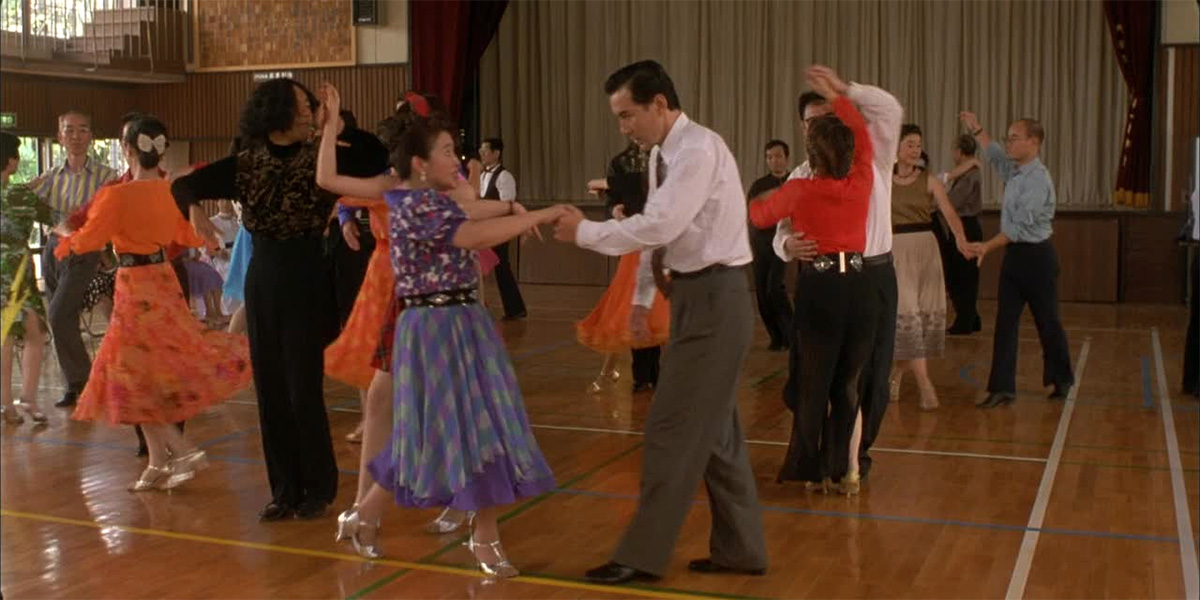Nearly a decade before ‘Strictly Come Dancing’ and its numerous international versions made ballroom dancing an ‘acceptable’ form of entertainment for the under 60s, Masayuki Suo used the art as the centrepiece for his grand masterpiece ‘Shall We Dance?’. Lauded by critics on its release and with box-office figures to match, the film was – inevitably – remade by Hollywood. I may be putting whatever reputation as a reviewer I have on the line by saying it, but the Richard Gere/Jennifer Lopez ‘Shall We Dance?’ was really rather sweet and may be as near to Asian sentiments as Hollywood blockbusters ever get. Nevertheless, Masayuki Suo’s original is something very special indeed and perhaps impossible to perfectly reconstruct in a remake; we therefore look at that 1996 classic in a little bit more detail.
The story starts with a Reginald Perrin-style montage of lead character Sugiyama’s uninspiring day-to-day routine. He has a doting wife and a loving daughter, but the sheer monotony of the daily grind is slowly destroying him inside. On the evening train home, the haggard office worker spota a beautiful, yet equally pained face peering out of the window of an apartment block and resolves to find out who she is. On discovering that she is the teacher at a Tokyo dance studio, Sugiyama plucks up the bravery to join the beginners’ class and meets a quirky mixture of amateurs, each with their own reason for attending. Sugiyama gradually finds the pull of the waltz to be addictive and slowly progresses to being a reasonably competent dancer. He also notices that a spirited samba dancer – complete with awkward wig and false tan – is actually the bullied worker Aoki who works in his department at work. Aoki helps his new friend to expand his horizons and takes him to amateur dances at the weekend.
Sugiyama’s secret dance lessons are arousing the suspicions of his spouse who smells the perfume on his shirts and notices his continued absence from the family’s evening meal and comes to a worrying conclusion. Keen to find about what she thinks is her husband’s infidelity, she hires a private detective to uncover the truth and meanwhile tries to decipher his odd behaviour. The truth about Sugiyama’s nocturnal activities surprises everyone though and the deeper reasons for his discontent gradually comes to the surface.
‘Shall We Dance?’ opens with a strangely haunting ten minutes of Sugiyama’s ennui and deep depression over what could be interpreted as his mid-life crisis. Yet, unlike the usual Western dissection of this subject matter, where the protagonist is almost destined to seek solace in the arms of someone younger, as if we should view this as an ordinary symptom of reaching middle-age, Masayuki Suo provides us with one of the most uplifting experiences committed to celluloid. There is pathos and humour flawlessly blended together in ‘Shall We Dance?’ and even moments of quiet introspection that turn familiar characters into three-dimensional figures.
These aforementioned characters add the necessary layers of interest, all their quirks and imperfections becoming more than just a little endearing by the end. The bolshy firebrand Toyoko has, as is expected, a soft centre, but the way her development is handled shows how accomplished the man behind the lens is. Even larger-than-life protagonists like the delightful Aoki (played by the fabulous Naoto Takenaka) have the vital humanity that gives ‘Shall We Dance?’ an earnest emotional punch. This helps the inevitable redemptive scenes near the end of the film – where each person uses the burgeoning prowess attained from dancing to confront the other issues they have to face – to gain real poignancy.
Masayuki Suo has constructed an often hilarious comedy mixed with a tender kernel that proves to be irresistible. The underdog or the underappreciated everyman may not be impossible heroes in the world of cinema – Asia is often adept at championing them – but when their stories are told with such care, it is impossible not to applaud the excellence we’re left with.
- Fight For Tomorrow - December 21, 2025
- Mission Kiss And Kill - December 7, 2025
- Yojimbo - November 24, 2025






